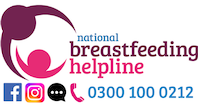This information can also be viewed as a PDF by clicking here.
The information provided is taken from various reference sources. It is provided as a guideline. No responsibility can be taken by the author or the Breastfeeding Network for the way in which the information is used. Clinical decisions remain the responsibility of medical and breastfeeding practitioners. The data presented here is intended to provide some immediate information but cannot replace input from professionals.
In 2008 Janssen-Cilag the manufacturers of Daktarin oral gel ® altered the licensed application of the product with respect to the age from which it is recommended. They recommend that it is not licensed for use in babies under 4 months of age and only with care between 4 and 6 months (EMC).
Despite conversations with the manufacturers and breastfeeding experts in USA, Canada and Australia it proved difficult to discover the reason for the change. It appears to originate from the concerns regarding the administration of the gel and the infant choking on the viscosity of the gel, rather than the medication itself (The Royal Women’s Hospital).
This change appears to originate from a published report (De Vries 1996) documenting a 17 day old baby (born at 36 weeks gestation) who choked when exposed to miconazole oral gel applied to her mother’s nipples before and after feeds on the advice of a pharmacist. The baby suddenly stopped feeding and breathing, became cyanotic and lost consciousness. The mother scooped out the visible miconazole gel and the baby recovered within a few moments. The doctor who was called could find no abnormalities and the baby recovered without further problem. The report mentions nine other cases of babies who suffered some form of difficulty with breathing, one of who was admitted to hospital, but all recovered spontaneously.
The alternative licensed anti-fungal agents available to teat oral candida (thrush) in an infant below 4 months of age are nystatin oral suspension and oral fluconazole suspension for the baby. The current research evidence for nystatin is poor according to Hoppe (1996, 1997).
If practitioners choose to continue to recommend miconazole oral gel they should ensure that the mother/carer is aware that the gel should be applied gently, in small amounts at a time until all the surfaces of the mouth are covered. It is important that a spoon is not used to administer the gel and that the back of the throat is not touched either by the adult’s finger or by the gel (Ainsworth 2009).
Healthcare providers must ensure that when recommending this product that the parent/carer is aware of how to apply the gel safely i.e. using a clean finger, apply small amounts of gel at a time, four times a day after feeds.
Practitioners who recommend miconazole oral gel that responsibility in a baby under 4 months lies with the person who prescribes or recommends its use.
The licensed application does not necessarily imply a risk if used appropriately but each prescription should be considered on an individual basis. Under no circumstances should miconazole oral gel be applied to the mother’s nipples as a means of treating the baby or the mother.
References
- Ainsworth S and Jones W. It sticks in our throats too. BMJ 2009;337:3178
- De Vries TW, Wewerinke ME, de Langen JJ. [Near asphyxiation of a neonate due to miconazole oral gel Ned Tijschr Geneeskd 2006;148:1598–600
- Electronic Medicines compendium – miconazole oral gel SPC emc.medicines.org.uk
- Hoppe JE, Hahn H. Randomized comparison of two nystatin oral gels with miconazole oral gel for treatment of oral thrush in infants. Antimycotics Study Group. Infection. 1996 Mar-Apr; 24(2): 136-9.
- Hoppe JE. Treatment of oropharyngeal candidiasis in immunocompetent infants: a randomised multicenter study of miconazole gel vs. nystatin suspension. The Antifungals Study Group. Pediatr Infect Dis J. 1997 Mar; 16(3): 288-93.
- The Royal Women’s Hospital www.thewomens.org.au/ThrushinLactation
©Dr Wendy Jones MBE, MRPharmS and the Breastfeeding Network Sept 2019

